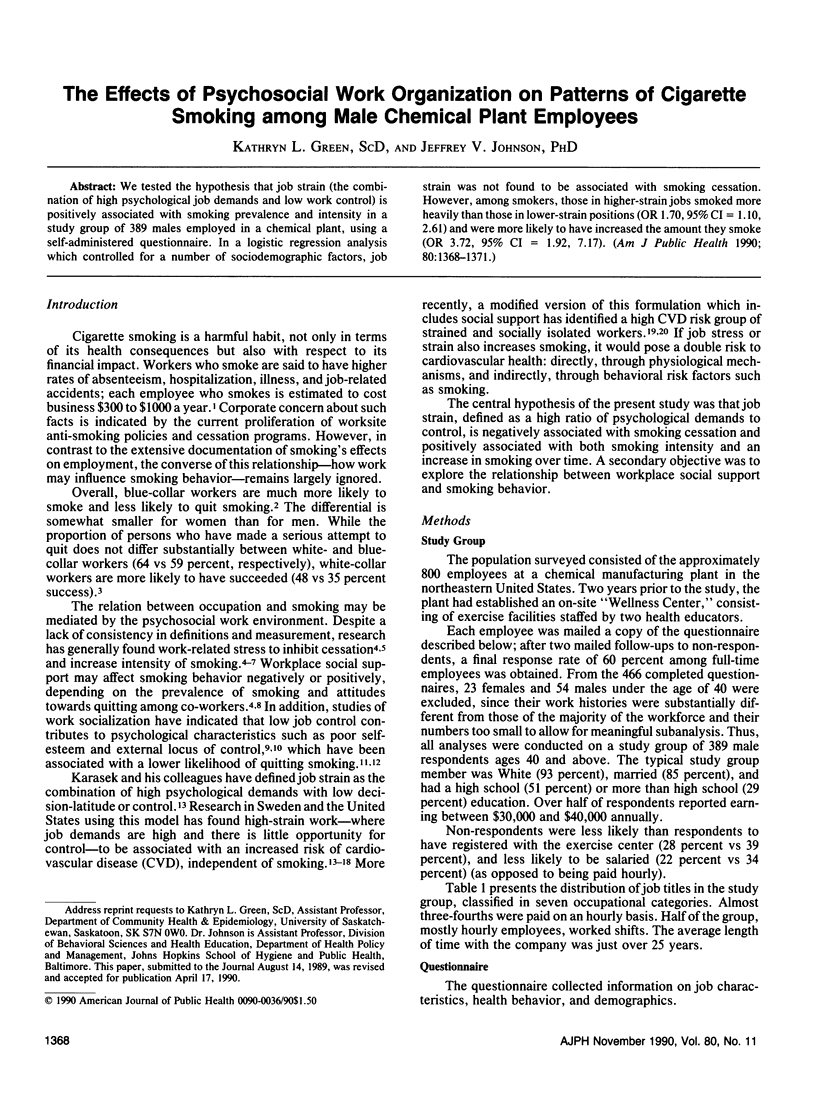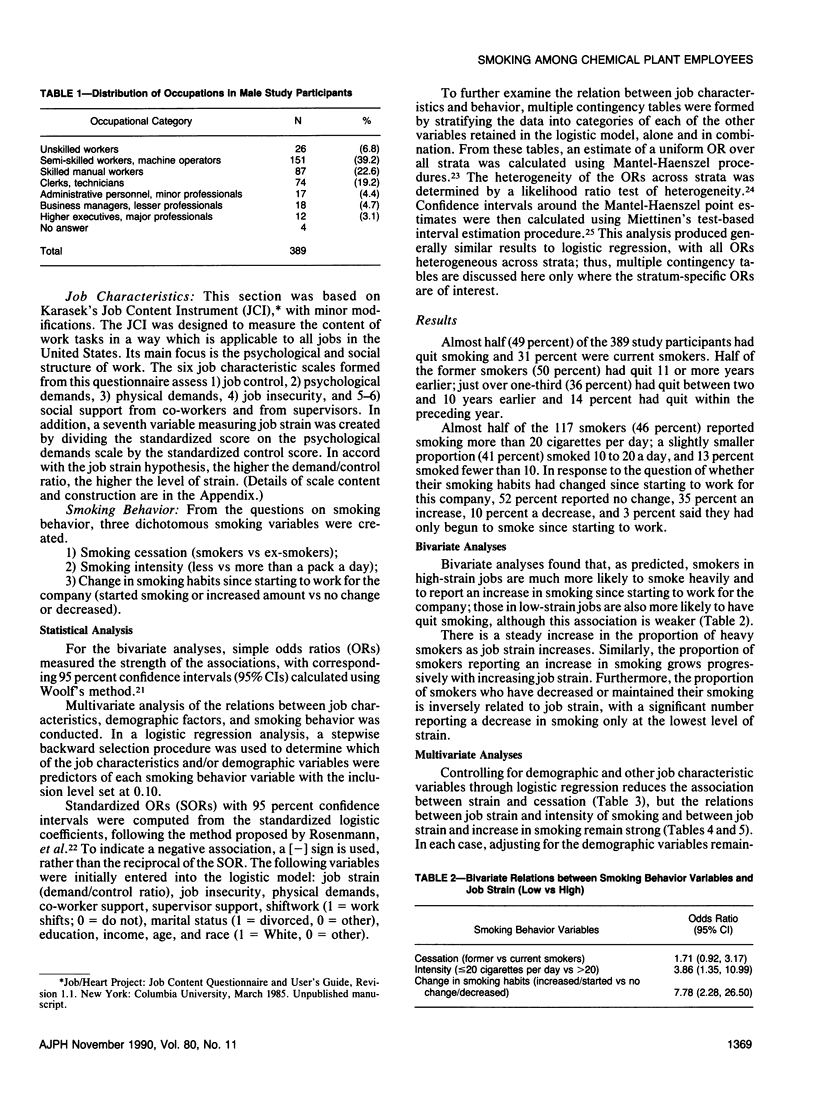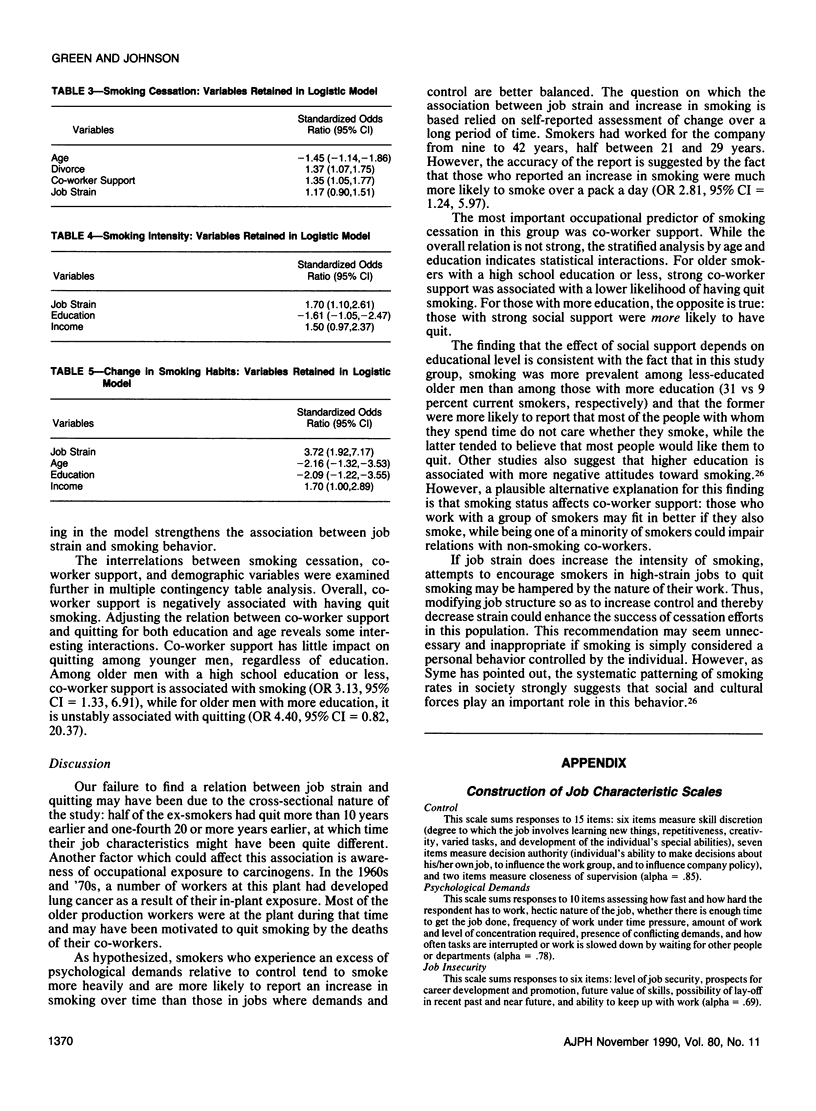Abstract
We tested the hypothesis that job strain (the combination of high psychological job demands and low work control) is positively associated with smoking prevalence and intensity in a study group of 389 males employed in a chemical plant, using a self-administered questionnaire. In a logistic regression analysis which controlled for a number of sociodemographic factors, job strain was not found to be associated with smoking cessation. However, among smokers, those in higher-strain jobs smoked more heavily than those in lower-strain positions (OR 1.70, 95% CI = 1.10, 2.61) and were more likely to have increased the amount they smoke (OR 3.72, 95% CI = 1.92, 7.17).
Full text
PDF



Selected References
These references are in PubMed. This may not be the complete list of references from this article.
- Alfredsson L., Karasek R., Theorell T. Myocardial infarction risk and psychosocial work environment: an analysis of the male Swedish working force. Soc Sci Med. 1982;16(4):463–467. doi: 10.1016/0277-9536(82)90054-5. [DOI] [PubMed] [Google Scholar]
- Alfredsson L., Spetz C. L., Theorell T. Type of occupation and near-future hospitalization for myocardial infarction and some other diagnoses. Int J Epidemiol. 1985 Sep;14(3):378–388. doi: 10.1093/ije/14.3.378. [DOI] [PubMed] [Google Scholar]
- Alfredsson L., Theorell T. Job characteristics of occupations and myocardial infarction risk:effect of possible confounding factors. Soc Sci Med. 1983;17(20):1497–1503. doi: 10.1016/0277-9536(83)90094-1. [DOI] [PubMed] [Google Scholar]
- Caplan R. D., Cobb S., French J. R., Jr Relationships of cessation of smoking with job stress, personality, and social support. J Appl Psychol. 1975 Apr;60(2):211–219. doi: 10.1037/h0076471. [DOI] [PubMed] [Google Scholar]
- Conway T. L., Vickers R. R., Jr, Ward H. W., Rahe R. H. Occupational stress and variation in cigarette, coffee, and alcohol consumption. J Health Soc Behav. 1981 Jun;22(2):155–165. [PubMed] [Google Scholar]
- House J. S., Strecher V., Metzner H. L., Robbins C. A. Occupational stress and health among men and women in the Tecumseh Community Health Study. J Health Soc Behav. 1986 Mar;27(1):62–77. [PubMed] [Google Scholar]
- Johnson J. V., Hall E. M. Job strain, work place social support, and cardiovascular disease: a cross-sectional study of a random sample of the Swedish working population. Am J Public Health. 1988 Oct;78(10):1336–1342. doi: 10.2105/ajph.78.10.1336. [DOI] [PMC free article] [PubMed] [Google Scholar]
- Johnson J. V., Hall E. M., Theorell T. Combined effects of job strain and social isolation on cardiovascular disease morbidity and mortality in a random sample of the Swedish male working population. Scand J Work Environ Health. 1989 Aug;15(4):271–279. doi: 10.5271/sjweh.1852. [DOI] [PubMed] [Google Scholar]
- Kaplan G. D., Cowles A. Health locus of control and health value in the prediction of smoking reduction. Health Educ Monogr. 1978 Spring;6(2):129–137. doi: 10.1177/109019817800600104. [DOI] [PubMed] [Google Scholar]
- Karasek R. A., Theorell T., Schwartz J. E., Schnall P. L., Pieper C. F., Michela J. L. Job characteristics in relation to the prevalence of myocardial infarction in the US Health Examination Survey (HES) and the Health and Nutrition Examination Survey (HANES). Am J Public Health. 1988 Aug;78(8):910–918. doi: 10.2105/ajph.78.8.910. [DOI] [PMC free article] [PubMed] [Google Scholar]
- Karasek R., Baker D., Marxer F., Ahlbom A., Theorell T. Job decision latitude, job demands, and cardiovascular disease: a prospective study of Swedish men. Am J Public Health. 1981 Jul;71(7):694–705. doi: 10.2105/ajph.71.7.694. [DOI] [PMC free article] [PubMed] [Google Scholar]
- Kristein M. M. Wanted: smoking policies for the work place. Bus Health. 1984 Nov;2(1):14–17. [PubMed] [Google Scholar]
- Rosenman R. H., Brand R. J., Sholtz R. I., Friedman M. Multivariate prediction of coronary heart disease during 8.5 year follow-up in the Western Collaborative Group Study. Am J Cardiol. 1976 May;37(6):903–910. doi: 10.1016/0002-9149(76)90117-x. [DOI] [PubMed] [Google Scholar]
- Sorensen G., Pechacek T., Pallonen U. Occupational and worksite norms and attitudes about smoking cessation. Am J Public Health. 1986 May;76(5):544–549. doi: 10.2105/ajph.76.5.544. [DOI] [PMC free article] [PubMed] [Google Scholar]
- Theorell T., Hamsten A., de Faire U., Orth-Gomér K., Perski A. Psychosocial work conditions before myocardial infarction in young men. Int J Cardiol. 1987 Apr;15(1):33–46. doi: 10.1016/0167-5273(87)90290-7. [DOI] [PubMed] [Google Scholar]
- Westman M., Eden D., Shirom A. Job stress, cigarette smoking and cessation: the conditioning effects of peer support. Soc Sci Med. 1985;20(6):637–644. doi: 10.1016/0277-9536(85)90402-2. [DOI] [PubMed] [Google Scholar]


